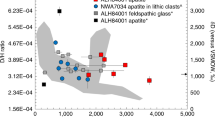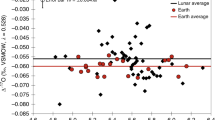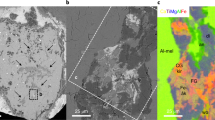Abstract
Initial analyses of lunar samples returned by the Apollo missions indicated that the Moon was essentially devoid of water. However, improved analytical techniques have revealed that pyroclastic glass beads in Apollo samples contain measurable amounts of water. Taking into account volatile loss during eruption of the glass beads onto the surface, the pre-eruption magma could have contained water on the order of 100 ppm by weight, concentrations that are similar to the mantle sources of mid-ocean ridge basalts on Earth. Lava flows from vast basaltic plains — the lunar maria — also contain appreciable amounts of water, as shown by analyses of apatite in mare basalt samples. In contrast, apatite in most non-mare rocks contains much less water than the mare basalts and glass beads. The hydrogen isotopic composition of lunar samples is relatively similar to that of the Earth's interior, but the deuterium to hydrogen ratios obtained from lunar samples seem to have a larger range than found in Earth's mantle. Thus, measurements of water concentration and hydrogen isotopic composition suggest that water is heterogeneously distributed in the Moon and varies in isotopic composition. The variability in the Moon's water may reflect heterogeneity in accretion processes, redistribution during differentiation or later additions by volatile-rich impactors.
This is a preview of subscription content, access via your institution
Access options
Subscribe to this journal
Receive 12 print issues and online access
$259.00 per year
only $21.58 per issue
Buy this article
- Purchase on Springer Link
- Instant access to full article PDF
Prices may be subject to local taxes which are calculated during checkout




Similar content being viewed by others
References
Saal, A. E. et al. Volatile content of lunar volcanic glasses and the presence of water in the Moon's interior. Nature 454, 192–195 (2008).
McCubbin, F. M. et al. Nominally hydrous magmatism on the Moon. Proc. Natl Acad. Sci. USA 107, 11223–11228 (2010).
Hartmann, W. K. & Davis, D. R. Satellite-sized planetesimals and lunar origin. Icarus 24, 504–515 (1975).
Cameron, A. G. W. & Ward, W. The origin of the Moon (abstr.). Lunar Sci. VII 120–122 (1976).
Canup, R. M. Simulations of a late lunar-forming impact. Icarus 168, 433–456 (2004).
Desch, S. J. & Taylor, G. J. A model of the Moon's volatile depletion. 42nd Lunar Planet. Sci. Conf. abstr. 1608 (2011).
Desch, S. J. & Taylor, G. J. Isotopic mixing due to interaction between the protolunar disk and the Earth's atmosphere. 44th Lunar Planet. Sci. Conf. abstr. 1719 (2013).
Warren, P. H. & Taylor, G. J. in Treatise on Geochemistry, Vol. 1 (Davis, A. ed.) 213–242 (Elsevier, 2014).
Shearer, C. K. et al. Thermal and magmatic evolution of the moon. Rev. Mineral. Geochem. 60, 365–518 (2006).
Bottke, W. F., Walker, R. J., Day, J. M. D., Nesvorny, D. & Elkins-Tanton, L. Stochastic late addition to Earth, the Moon, and Mars. Science 330, 1527–1530 (2010).
Saal, A. E., Hauri, E. H., Rutherford, M. J. & Cooper, R. F. The volatile contents (CO2, H2O, F, S, Cl) of the lunar picritic glasses. 38th Lunar Planet. Sci. Conf. abstr. 2148 (2007).
Hauri, E. SIMS analysis of volatiles in silicate glasses, 2: isotopes and abundances in Hawaiian melt inclusions. Chem. Geol. 183, 115–141 (2002).
Hauri, E. H., Wang, J., Dixon, J. E., King, P. L., Mandeville, C. & Newman, S. SIMS investigations of volatiles in volcanic glasses, 1: calibration, sensitivity and comparisons with FTIR. Chem. Geol. 183, 99–114 (2002).
Saal, A. E., Hauri, E. H., Langmuir, C. H. & Perfit, M. R. Vapor undersaturation in primitive mid-ocean ridge basalt and the volatile content of the Earth's upper mantle. Nature 419, 451–455 (2002).
Hauri, E. H., Gaetani, G. A. & Green, T. H. Partitioning of water during melting of the Earth's upper mantle at H2O-undersaturated conditions. Earth Planet. Sci. Lett. 248, 715–734 (2006).
Delano, J. Pristine lunar glasses: criteria, data, and implications. J. Geophys. Res. 91, D201–D213 (1986).
Grove, T. L., Till, C. B. & Krawczynski, M. J. The role of H2O in subduction zone magmatism. Annu. Rev. Earth Planet. Sci. 40, 413–439 (2012).
Hauri, E. H., Weinreich, T., Saal, A. E., Rutherford, M. C. & Van Orman, J. A. High pre-eruptive water contents preserved in lunar melt inclusions. Science 333, 213–215 (2011).
Saal, A. E., Hauri E. H., Van Orman J. A. & Rutherford M. J. Hydrogen isotopes in lunar volcanic glasses and melt inclusions reveal a carbonaceous chondrite heritage. Science 340, 1317–1320 (2013).
Boettcher, A. L. & O'Neil, J. R. Stable isotope, chemical and petrographic studies of high pressure amphiboles and micas: evidence for metasomatism in the mantle source regions of alkali basalts sand kimberlites. Am. J. Sci. 280A, 594–621 (1980).
Michael, P. J. The concentration, behavior and strorage of H2O in the suboceanic upper mantle: implications for mantle metasomatism. Geochim. Cosmochim. Acta 52, 555–566 (1988).
Ahrens, T. J. Water storage in the upper mantle. Nature 342, 122–123 (1989).
Deloule, E., Albarède, F. & Sheppard, S. M. F. Hydrogen isotope heterogeneities in the mantle from ion probe analysis of amphiboles from ultramafic rocks. Earth. Planet. Sci. Lett. 105, 543–553 (1991).
Bell, D. R. & Rossman, G. R. Water in Earth's mantle: the role of nominally anhydrous minerals. Science 255, 1391–1396 (1992).
Thompson, A. B. Water in the Earth's upper mantle. Nature 358, 295–302 (1992).
Graham, C., Kinny, P., Harte, B. & Valley, J. The nature and scale of stable isotope disequilibrium in the mantle: ion and laser microprobe evidence. Mineral. Mag. 58A, 345–346 (1994).
Jambon, A. in Volatiles in Magmas (eds Carroll, M. R. & Holloway, J. R.) 479–517 (Rev. Mineral. 30, Mineral. Soc. Am., 1994).
Wagner, C., Deloule, E., Mokhtari & A. Richterite-bearing peridotites and MARID-type inclusions in lavas from North Eastern Morocco: mineralogy and D/H isotopic studies. Cont. Min. Petrol. 124, 406–421 (1996).
Xia, Q-K., Deloule, E., Wu, Y-B., Chen, D-G. & Cheng, H. Anomalously high δD values in the mantle. Geophys. Res. Lett. 29, 2008 (2002).
Eugster, O. et al. The cosmic-ray exposure history of Shorty Crater samples: the age of Shorty Crater. Proc. 8th Lunar Planet. Sci. Conf. 3059–3082 (1977).
Füri, E., Deloule, E., Gurenko, A. & Marty, B. New evidence for chondritic lunar water from combined D/H and noble gas analyses of single Apollo 17 volcanic glasses. Icarus 229, 109–120 (2014).
Gaetani, G. A., O'Leary, J. A., Shimizu, N., Bucholz, C. & Newville, M. Rapid equilibration of H2O and oxygen fugacity in olivine-hosted melt inclusions. Geology 40, 915–918 (2012).
Watson, L. L., Hutcheon, I. D., Epstein, S. & Stolper, E. M. Water on Mars: clues from D/H and water contents of hydrous phases in SNC meteorites. Science 265, 85–90 (1994).
Boctor, N. Z., O'D Alexander, C. M., Wang, J. & Hauri, E. The sources of water in martian meteorites: clues from hydrogen isotopes. Geochim. Cosmochim. Acta 67, 3971–3989 (2003).
Greenwood, J. P., Itoh, S., Sakamoto, N., Vicenzi, E. P. & Yurimoto, H. Hydrogen isotope evidence for loss of water from Mars through time. Geophys. Res. Lett. 35, L05203 (2008).
Hallis, L. J., Taylor, G. J., Nagashima, K. & Huss, G. R. Magmatic water in the martian meteorite Nakhla. Earth Planet. Sci. Lett. 359–360, 84–92 (2012).
McCubbin, F. M., Nekvasil, H. & Lindsley, D. H. Evidence for water in lunar magmatic minerals? A crystal chemical investigation. 38th Lunar Planet. Sci. Conf. abstr. 1354 (2007).
McCubbin, F. M. et al. Fluorine and chlorine abundances in lunar apatite: implications for heterogeneous distributions of magmatic volatiles in the lunar interior. Geochim. Cosmochim. Acta 75, 5073–5093 (2011).
McCubbin, F. M. et al. Detection of structurally bound hydroxyl in apatite from Apollo mare basalt 15058,128 using TOF-SIMS. Am. Mineral. 9, 1141–1150 (2010).
Boyce, J. W. et al. Lunar apatite with terrestrial volatile abundances. Nature 466, 466–469 (2010).
Greenwood, J. P. et al. Apollo rock samples and the D/H of lunar apatite. 41st Lunar Planet. Sci. Conf. abstr. 2439 (2010).
Greenwood, J. P. et al. Hydrogen isotope ratios in lunar rocks indicate delivery of cometary water to the Moon. Nature Geosci. 4, 79–82 (2011).
Barnes, J. J. et al. Accurate and precise measurements of the D/H ratio and hydroxyl content in lunar apatites using NanoSIMS. Chem. Geo. 337–338, 48–55 (2013).
Tartèse, R. & Anand, M. Late delivery of chondritic hydrogen into the lunar mantle: insights from mare basalts. Earth Planet. Sci. Lett. 361, 480–486 (2013).
Tartèse, R. et al. The abundance, distribution, and isotopic composition of hydrogen in the Moon as revealed by basaltic lunar samples: implications for the volatile inventory of the Moon. Geochim. Cosmochim. Acta 122, 58–74 (2013).
Boyce, J. W., Tomlinson, S. M., McCubbin, F. M., Greenwood, J. P. & Treiman A. H. The lunar apatite paradox. Science Express (20 March 2014).
Hirschmann, M. M., Wirthers, A. C., Ardia, P. & Foley, N. T. Solubility of molecular hydrogen in silicate melts and consequences for volatile evolution of terrestrial planets. Earth Planet. Sci. Lett. 345–348, 38–48 (2012).
Koga, K., Hauri, E., Hirschmann, M. & Bell, D. Hydrogen concentration analyses using SIMS and FTIR: comparison and calibration for nominally anhydrous minerals. Geochem. Geophys. Geosys. 4, 1019 (2003).
Aubaud, C., Hauri, E. H. & Hirschmann, M. M. Water partitioning coefficients between nominally anhydrous minerals and basaltic melts. Geophys. Res. Lett. 31, L20611 (2004).
Grant, K. J., Kohn, S. C. & Brooker, R. A. The partitioning of water between olivine, orthopyroxene and melt synthesized in the system albite-forsterite-H2O. Earth Planet. Sci. Lett. 3260, 227–241 (2007).
Sharp, Z. D., McCubbin, F. M. & Shearer, C. K. A hydrogen-based oxidation mechanism relevant to planetary formation. Earth Planet. Sci. Lett. 380, 88–97 (2013).
Robinson K. L ., Taylor, G. J., Hellebrand, E. & Nagashima, K. KREEP, KREEP derivatives, and the lunar D enrichment? Euro. Planet. Sci. Cong. 2012 abstr. 283 (2012).
Robinson, K. L., Taylor, G. J. & Nagashima, K. D/H of intrusive moon rocks: implications for lunar origin. 44th Lunar Planet Sci. Conf. abstr. 1327 (2013).
Tartèse, R. et al. Apatites in lunar KREEP basalts: the missing link to understanding the H isotope systematics of the Moon. Geology 42, 363–366 (2014).
Barnes, J. J. et al. The origin of water in the primitive Moon as revealed by the lunar highlands samples. Earth Planet. Sci. Lett. 390, 244–252 (2014).
Hui, H., Peslier, A., Zhang, Y. & Neal, C. R. Water in lunar anorthosites and evidence for a wet early Moon. Nature Geosci. 6, 177–180 (2013).
Klima, R., Cahill, J., Hagerty, J. & Lawrence, D. Remote detection of magmatic water in Bullialdus Crater on the Moon. Nature Geosci. 6, 737–741 (2013).
Bhattacharya, S. et al. Endogenic water on the Moon associated with non-mare silicic volcanism: implications for hydrated lunar interior. Curr. Sci. 105, 685–691 (2013).
Jolliff, B. L. et al. Non-mare silicic volcanism on the lunar farside at Compton-Belkovich. Nature Geosci. 4, 566–571 (2011).
Sharp, Z. D., Shearer, C. K., McKeegan, K. D., Barnes, J. D. & Wang, Y. Q. The chlorine isotope composition of the Moon and implications for an anhydrous mantle. Science 329, 1050–1053 (2010).
Longhi, J. Experimental petrology and petrogenesis of mare volcanics. Geochim. Cosmochim. Acta 56, 2235–2251 (1992).
Wieczorek, M. A. et al. The crust of the Moon as seen by GRAIL. Science 339, 671–675 (2013).
Panet-Fisher, J. F. et al. The significance of OH contents in lunar apatites. 45th Lunar Planet. Sci. Conf. abstr. 2719 (2014).
Paniello, R. C., Day, J. M. D. & Moynier, F. Zinc isotopic evidence for the origin of the Moon. Nature 490, 376–379 (2012).
Mottl, M. J., Glazer, B. T., Kaiser, R. I. & Meech, K. J. Water and astrobiology. Chem. Erde 67, 253–282 (2007).
Hartogh, P. et al. Ocean-like water in the Jupiter-family comet 103P/Hartley 2. Nature 478, 218–220 (2011).
Eberhardt, P., Reber, M., Krankowsky, D. & Hodges, R. R. The D/H and18O/16O ratios in water from comet P/Halley. Astron. Astrophys. 302, 301–316 (1995).
Bockele e-Morvan. et al. T. Deuterated water in comet C/1996 B2 (Hyakutake) and its implications for the origin of comets. Icarus 133, 147–162 (1998).
Meier, R. et al. A determination of the HDO/H20 ratio in comet C/1995 01 (Hale-Bopp). Science 279, 842–844 (1998).
O'D Alexander, C. M. et al. The provenances of asteroids, and their contributions to the volatile inventories of the terrestrial planets. Science 337, 721–723 (2012).
Dixon, J. E., Stolper, E. M. & Holloway J. R. An experimental study of water and carbon dioxide solubilities in mid-ocean ridge basaltic liquids: I. Calibration and solubility models. J. Petrol. 36, 1607–1631 (1995).
Maxwell, J. A., Peck, L. C. & Wiik, H. B. Chemical composition of Apollo 11 lunar samples 10017, 10020, 10072, and 10084. Proc. Apollo 11 Lunar Sci. Conf. 1369–1374 (1970).
Basaltic Volcanism Study Project Basaltic Volcanism on the Terrestrial Planets (Pergamon Press, 1981).
Wolf, R. & Anders, E. Moon and Earth: compositional differences inferred from siderophiles, volatiles and alkalies in basalts. Geochim. Cosmochim. Acta 44, 2111–2124 (1980).
Latham, G. V. et al. Apollo 11 passive seismic experiment. Proc. Apollo 11 Lunar Science Conf. 2309–2320 (1970).
Toksoz, M. N., Dainty, A. M., Solomon, S. C. & Anderson, K. R. Structure of the Moon. Rev. Geophys. Space Phys. 12, 539–567 (1974).
Tittmann, B. R, Clark, V. A & Spencer, T. Compressive strength, seismic Q, and elastic modulus. Proc. 11th Lunar Planet. Sci. Conf. 1815–1823 (1980).
Tittmann, B. R. et al. Internal friction quality-factor Q under confining pressure. Proc. 8th Lunar Sci. Conf. 1209–1224 (1977).
Gibson, E. K. & Johnson, S. M. Thermal analysis-inorganic gas release studies of lunar samples. Proc. 2nd Lunar Sci. Conf. 1351–1366 (1971).
Epstein, S. & Taylor, H. P. D/H and 18O/16O ratios of H2O in the 'rusty' breccia 66095 and the origin of 'lunar water'. Proc. 5th Lunar Sci. Conf. 1839–1854 (1974).
Lecuyer, C., Gillet P. & Robert F. The hydrogen isotope composition of seawater and the global water cycle. Chem. Geo. 145, 249–261 (1998).
Taylor, L. A., Mao, H. K. & Bell, P. M. 'Rust' in the Apollo 16 rocks. Proc. 4th Lunar Sci. Conf. 829–839 (1973).
Taylor, L. A., Mao, H. K. & Bell P. M. Identification of the hydrated iron oxide mineral akaganeite in Apollo 16 lunar rocks. Geology 2, 429–432 (1974).
Elkins-Tanton, L. T. & Grove, T. L. Water (hydrogen) in the lunar mantle: results from petrology and magma ocean modelling. Earth Planet. Sci. Lett. 307, 173–179 (2011).
Zhang, Y. 'Water' in lunar basalts: the role of molecular hydrogen (H2), especially in the diffusion of the H component. 42nd Lunar Planet. Sci. Conf. abstr. 1957 (2011).
Huss, G. R., Nagashima, K., Burnett, D. S., Jurewicz, A. J. G., & Olinger, C. T. A new upper limit on the D/H ratio in the solar wind. 43rd Lunar Planet. Sci. Conf. abstr 1709 (2012).
Hagemann, R., Nief, G. & Roth, E. Absolute isotopic scale for deuterium analysis of natural waters. Absolute D/H ratio for SMOW. Tellus 22, 712–715 (1970).
Merlivat, L., Leiu, M., Neif, G. & Roth, E. Spallation deuterium in rock 70215. Proc. 7th Lunar Sci. Conf. 649–658 (1976).
Reedy, R. C. Cosmic-ray-produced stable nuclides: various production rates and their implications. Proc. 12th Lunar Sci. Conf. 12B, 1809–1823 (1981).
Kirsten, T. & Horn, P. Chronology of the Taurus-Littrow region III: ages of mare basalts and highland breccias and some remarks about the interpretation of lunar highland rock ages. Proc. 5th Lunar Sci. Conf. 1451–1475 (1974).
Mathez, E. A. & Webster, J. D. Partitioning behavior of chlorine and fluorine in the system apatite-silicate melt-fluid. Geochim. Cosmochim. Acta 69, 1275–1286 (2005).
Longhi, J. Petrogenesis of picritic mare magmas: constraints on the extent of early lunar differentiation. Geochim. Cosmochim. Acta 70, 5919–5934 (2006).
Acknowledgements
This research was supported by the National Aeronautics and Space Administration through the NASA Astrobiology Institute under Cooperative Agreement No. NNA09DA77A issued through the Office of Space Science, and by NASA Lunar Advanced Science and Exploration Research Grant NNX11AE85G. We thank all colleagues working on water in the Moon for lively and informative discussions.
Author information
Authors and Affiliations
Corresponding author
Ethics declarations
Competing interests
The authors declare no competing financial interests.
Rights and permissions
About this article
Cite this article
Robinson, K., Taylor, G. Heterogeneous distribution of water in the Moon. Nature Geosci 7, 401–408 (2014). https://doi.org/10.1038/ngeo2173
Received:
Accepted:
Published:
Issue Date:
DOI: https://doi.org/10.1038/ngeo2173
This article is cited by
-
Analysing orbits around the Moon for the Garatéa-L Mission
Astrophysics and Space Science (2024)
-
Microbial biomanufacturing for space-exploration—what to take and when to make
Nature Communications (2023)
-
A dry lunar mantle reservoir for young mare basalts of Chang’e-5
Nature (2021)
-
An extremely heavy chlorine reservoir in the Moon: Insights from the apatite in lunar meteorites
Scientific Reports (2019)
-
Water and Volatile Inventories of Mercury, Venus, the Moon, and Mars
Space Science Reviews (2018)



